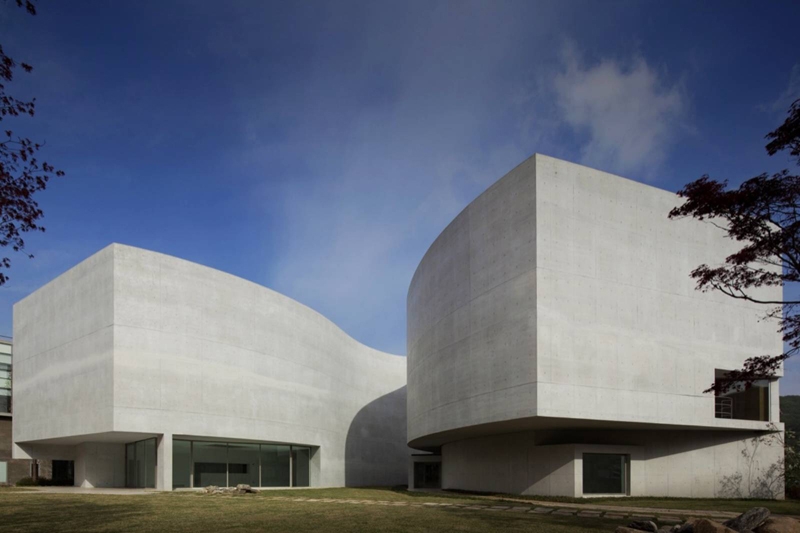While in South Korea in October to launch the Korean edition of my novel All the Way (published in French in 2013), I paid a visit to my publisher, Hong Ji-Woong. His publishing house, Open Books, is located in Paju, a new town an hour to the north of Seoul, at the end of a motorway lined with watchtowers and barbed wire. It’s a town dedicated to book production and constructed directly alongside the 38th parallel: from the top of the Lotte Premium Outlets supermarket one can see North Korea, entirely stripped of its forests, all sacrificed for firewood. Paju Book City was organised by the South Korean minister of culture at the beginning of the 2000s. Its new glass-and-metal buildings have sprouted from the earth not far from the military barracks that more normally populate this part of the world. Ten thousand employees work here, for around 250 companies: behind its disconcerting exterior, this new town is pleasant, well designed and leafy, with hip cafés, art galleries and artist studios. The idea was also that Seoul’s residents would come to this cultural centre to hang out on weekends, but according to locals, that didn’t really happen until after the vast Lotte shopping mall, with over 35,000sqm of floor space, opened in 2011.
The website for Paju Book City declares in English that ‘the city aims to recover the lost humanity’ [sic]. Such an ambition might make one smile, but after the Japanese occupation, an atrocious war, the partition of the country and the often-chaotic process of modernisation undergone in South Korea’s major cities, Paju Book City is at the very least an architectural success. Its jewel is the Mimesis Museum, and I was surprised by the scale and ambition of this private museum. Designed by Pritzker Prize-winner Álvaro Siza in collaboration with Castanheira & Bastai Arquitectos Associados and Jun Sung Kim, at the behest of Hong Ji- Woong, it houses the offices of Open Books (it is named after the company’s art imprint), a café and an art gallery open to the public. In the garden, two enormous beasts by Park Chan Yong warm their fantastical horns in the sunshine. And inside – light.
Hong had considered the architect Tadao Ando as well as Zaha Hadid, but a prospecting trip to Portugal in 2005 convinced him to chose Siza. The 3,663sqm-building was completed in 2009, with Siza given carte blanche. Glass, wood flooring, raw concrete: the undulating white walls slide beneath the natural light as if the photons no longer arranged themselves in straight lines but in large, calm curves. The staircases seem to produce their own brightness. Indeed, one finds oneself endlessly at crossroads of light, without fully knowing their source. All this extends to the point where, on the day of my visit, the photographs that were on show (a Min Byung-Hun solo exhibition) suffered by comparison to their sublime envelope: this pure and peaceful museum.
These private enterprises often have greater resources than the local communities that house them, or even the state itself
In Korea, the majority of the museums and galleries showing contemporary art are private. Many industrial conglomerates (such as Samsung Doosan and LG) have their own art foundations and several operate museums. In Busan, Korea’s great port town, for example, there is the Goeun Museum – an excellent private institution dedicated to contemporary photography. Opened in 2007, it was dreamed up and commissioned by a private patron who is, among other things, the local distributor for BMW. At the time of my visit it was hosting an exhibition of works by American photographer Ralph Gibson, and had shown the work of Frenchman Bernard Faucon the previous year. Not that the museum is dedicated solely to Western photographers, it’s just that its director, Sangil Yi (himself a photographer), told me he was particularly interested in mise-en-scène photography.
These private enterprises often have greater resources than the local communities that house them, or even the state itself. But institutions and public foundations such as ARKO (Arts Council Korea) or SFAC (Seoul Foundation for Arts and Culture), attached to provinces or cities, do actively promote contemporary art – and that’s a trend that has increased in force over the past five years: more public funding is now allocated to contemporary art and more public museums are under construction. The Chang Ucchin Museum of Art opened this past April in Yangju, in the province of Gyeonggi. It’s funded by the city. The Lee Ufan Museum, also publicly funded, is on a site in Daegu, Korea’s third city after Seoul and Busan. Much of South Korea’s economic output rests in the hands of family-controlled conglomerates, whose members often have positions of power in the government. It seems to me that in terms of the country’s cultural politics as well, a balance between public and private interests is always in the process of being struck.
This article was first published in the Spring 2015 issue of ArtReview Asia.
